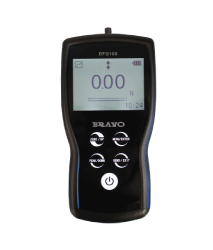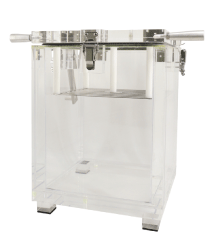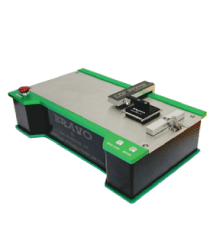Oxygen Index
What It's For
- New Paramagnetic Oxygen Cell for assessing accurate oxygen (< 0.1%) levels
- Compact unit for efficient use inside a laboratory hood, with ventilation
- Automatic flow control gives oxygen level adjustment by turning one single valve
- Quick loading of test specimen into test chimney measuring 450 mm × 75 mm
- Digital display of oxygen percentage in atmosphere during test (no calculations needed)
- Digital display of temperature of gas mixture entering the test chimney
- Sample holders for both rigid and flexible samples supplied
- Shortened gas path for rapid response
- Digital readout for oxygen concentration: +/- 0.1%
- Dimensions (mm): 350 (W) × 370 (D) x 280 (H)
- Column size (mm): 75 & 95 (dia) × 450 (H)
- Weight: 14 kg
- Voltage: 230V 50Hz 1A or 110V 60Hz 2A
- Operating Manual: Supplied
- Other Service requirements: Bottled O2/N2, Propane
Temperature Oxygen Index Apparatus
What It's For
- Test temperature to 400°C
- Digital display of sample temperature
- Digital display of column and pre-heater temperatures
- Transparent radiant heated test column
- Highly efficient gas pre-heater
- Air pump to conserve oxygen and nitrogen supply during standby period
- Digital readout for oxygen concentration: +/-0.1%
- Dimensions (mm): 350 (W) × 370 (D) × 280 (H)
- Column size (mm): 160 max (dia.) × 75mm (internal dia.) × 570 (H)
- Weight: 17 kg
- Voltage: 230V 50Hz 10.25A or 110V 60Hz 20.5A
- Operating Manual: Supplied
- Other Service requirements: Bottled O2/N2, Propane, Requires Oxygen Index
Horizontal/Vertical Flame Chamber
What's for
- Horizontal Burning Test; UL 94HB (ASTM D635, IEC 60695-11-10, IEC 60707, ISO 1210).
- Vertical Burning Test: UL 94 V-0, V-1, or V-2 (ASTM D3801, IEC 60695-11-10, IEC 60707, ISO 1210).
- 500 W (125mm) Vertical Burning Test: 5VA or 5VB (ASTM D5048, IEC 60695-11-20, IEC 60707, ISO 9772).
- Thin Material Vertical Burning Test: VTM-0, VTM-1, or VTM-2 (ASTM D4804, ISO 9773).
- Horizontal Burning Foamed Material Test: HF-1, HF-2 or HBF (ASTM D4986, ISO 9772).
- Burners (ASTM D5025, ASTM D5207, ISO 10093, ISO 103351)
The NFPA 269
- A bench mounted draft free combustion chamber with a large inside volume of 1.0m³ and fitted with an interior light and exhaust fan to enable simple evacuation of combustion products.
- Large door and window made from toughened safety glass giving a generous view of the specimen during a test. A specimen light is also fitted.
- Specimen holders.
- Fully adjustable horizontal and vertical specimen supports.
- A burner in compliance with ASTM D5025, with simple angle adjustment (0°, 20°, 45°) and precision gas control system including gas flow meter, pressure regulator and pressure gauge (Two access ports enabling easy entry to the chamber for movement of the burner and specimen).
- A burner wing tip.
- Three digital test duration timers for accurate but simplified operation with remote handset.
Vertical/Horizontal Wire Flame Test Apparatus
What's for
It conforms to UL 1581 vertical specimen Bunsen Burner tests and associated international standards. These are:
- 1060. Vertical Flame and FT1 Tests
- 1061. Cable Flame Test
- 1080. VW-1 (Vertical Specimen) Flame Test
- 1090. Horizontal-Specimen Appliance-Wire Flame Test
- 1100. Horizontal-Specimen / FT2 Flame Test
Ignitability Apparatus
What's for
The test apparatus consists of a support framework which clamps the test specimen horizontally between a pressing plate such that a defined area of the upper surface of the specimen is exposed to radiation.
This radiation is provided by a radiator cone positioned above and supported from the specimen support framework. An automated pilot flame application mechanism is used to bring a test flame through the radiator cone to a position above the centre of the surface of the specimen. A specimen insertion and location tray is used to position the specimen accurately on the pressing plate of the specimen support framework and a screening plate is used to shield the surface of the specimen during its insertion into the apparatus.
- Framework for the cone sample support mechanism
- Radiator cone assembly
- Radiation levels between 10-50kW/m² using a conical radiation furnace.
- Counter weight for pressing plate
- Pilot gas line with flashback arrestor and provision for re-ignition
- Pilot flame application mechanism and motor drive assembly to bring pilot flame into the correct position above the plane of sample, every 4 seconds
- Secondary ignition source
Single-Flame Source Test
What's For
- An extensively adjustable burner assembly, mounted on runners, to enable the small premixed flame to be tilted at an angle of 45° to the specimen and offered to it in one fluid movement
- Specimen holder capable of housing the specimens up to and including 60 mm thick
- A fully adjustable specimen support frame facilitating lateral movement of the specimen holder so that the flame can be applied either at the specimen centre position, or at laterally spaced points.
- A digital anemometer/thermometer and a stopwatch for simple but accurate measurement of the flow, temperature and time.
FMVSS 302
What's For
- Fully compliant to FMVSS 302 and ISO 3795 requirements depending on which sample holder is used.
- Complete and ready to use system.
- Low maintenance requirement.
- FMVSS 302
- ISO 3795
- ASTM D5132-04
FAR Bunsen Burner Test Apparatus
What's For
It enables the user to test according to five Federal Aviation Regulation (FAR) test methods:
- Vertical Bunsen burner test for cabin and cargo compartment materials
- 45-Degree Bunsen burner test for cargo compartment liners and waste stowage compartment materials
- Horizontal Bunsen burner test for cabin, cargo compartment, and miscellaneous materials
- 60-Degree Bunsen burner test for electric wire
- Recommended procedure for the 4-ply horizontal flammability test for aircraft blankets.



